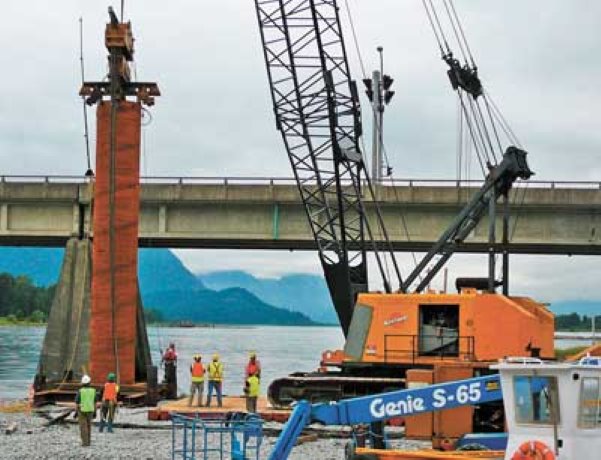The construction of the pilings supporting the piers for the new Pitt River bridge will push the envelope for British Columbia bridge construction, says project manager Ross Gilmour of Peter Kiewet Sons Ltd.
Bridge Construction
The construction of the pilings supporting the piers for the new Pitt River bridge will be pushing the envelope from what is normally seen in B.C. bridge construction, says Peter Kiewet Sons Ltd. project manager Ross Gilmour. “For piles of this size and the depth to which they are being driven, for all intensive purposes, we are pushing the envelope of what has been done. It is not the biggest pipe or the deepest in the world but it is on the edge of the envelope,” he says.
The Pitt River Bridge and Mary Hill Interchange Project includes a new fixed bridge to replace the existing swing bridges and an interchange to replace the existing Lougheed Highway and the Mary Hill Bypass intersection. The project is a stand-alone component of the North Fraser Perimeter Road Project.
The new cable-stayed bridge will be located between the existing, 1970-built bridge and a railway bridge. It will have three westbound lanes and four eastbound on opening day. It will also provide up to 16 metres of vertical marine clearance, as well as providing facilities for cyclists and pedestrians. The federal and provincial governments are funding the project. As part of its recent Asia-Pacific Gateway & Corridor Initiative, the Government of Canada has committed $90 million in funding for costs associated with the construction of the bridge and a new grade-separated interchange at Lougheed Highway and Mary Hill Bypass. The Province is providing $108 million. Completion date is November 2009.
Gilmour says pilings for the new bridge are being driven to a depth of 100 metres to support the piers for the new bridge. By comparison, the depth of piers driven for the existing bridge was 60 metres. (The new Golden Ears Bridge connecting Langley to Maple Ridge has piers driven to a 90 metre depth across the larger Fraser River).
“I wasn’t here then,” he says, when the existing Pitt River bridge was constructed, but, he guesses that technology had not advanced to drive piles deeper during the 1970s. (Over the years, there has been some noted sinking of the existing bridge structure.) Gilmour says that the area in which the Pitt River bridge sits is mainly clays and silts, which vary in depths throughout the Fraser Valley. “What it means is that there is nothing solid to get a foundation on until we get to that (100 metre) depth,” he says. Exploratory drilling has been done to ensure the foundation material exists at that level and is suitable.
The 2.5 centimetre-thick, steel pipe that is being driven into the ground has a six-foot (1.8 metres) diameter. It is being driven into the ground in 30, 80 and 100 foot sections. The pipe is either pushed or driven by pile driving equipment on site. Once the pipe has been significantly buried, “we take the next piece and weld it on and then start the process over again,” Gilmour says.
When pipe has hit the foundation material at the desired depth, the top quarter-length of materials is removed from the inside of the cylindrical pipe. “We remove about 25 to 30 metres and fill it with concrete,” he says. In total there will be 26 piles driven to support four piers – two main piers and two side piers. (See sketch at www.th.gov.bc.ca/gateway/ under Pitt River bridge heading. Cover page has graphics link at the bottom).
Only one set of piers will be placed in the river and it is one of two main piers, with the second located on the Pitt Meadows (east) side of the river. These two sets of piers will hold the main towers through which cable suspension lines will be passed. The main pier that is set in the Pitt River is actually located closer to the west side of the river than in the centre. “The east side (of the Pitt River) is the navigation channel,” says Gilmour.
The third set of piers (smaller) is set on the west (Port Coquitlam) side of the river, while the fourth set is set back further on the east (Pitt Meadows) side. Work has just started on two pilings. Once the first pipe pilings have been driven, says Gilmour, they will be subjected to a stress test. Because the engineering design is breaking new ground in terms of the pipe size and depth it is driven into at this location, Gilmour says there have only been drawing board projections on load capacity. The current load capacity per piling is 5,000 tons, but that estimate is considered conservative but needs to be proven out.
The test is performed by placing the piling to be tested in the centre of four other support pilings. Over this configuration is placed a square platform, but under the central pile is a jack. The platform is loaded to capacity and the jack lifts the platform, thus transferring the load from the dispersed four pilings to that of the central one, creating a force pushing down on the central piling. While engineers believe the structure to be able to handle the capacity, Gilmour says that if the structural test raises concerns, there is the ability in the design to add more piling to ensure safety. “We think we can effectively prove it out,” he says.











Recent Comments
comments for this post are closed